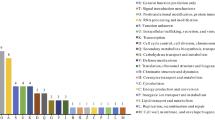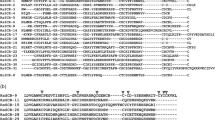Abstract
We have identified multiple alleles for a single gene termed W14/15. This gene encodes closely related but not identical proteins W14 and W15 that accumulate in overwinter buds of Gentiana triflora (Takahashi et al. in Breed Sci 56:39–46, 2006; Hikage et al. in Mol Genet Genomics 278:95–104, 2007). In this study, structural analysis of the W14/15 gene was carried out for 21 different gentian lines/cultivars consisting of 5 different species, to survey species- or line/cultivar-specific haplotypes. Within the samples examined, multiple variant forms were found. Those were categorized into seven major types (type I–VII) and ten subtypes based on the presence of three short insertion/deletion sites, three RFLP sites, and several SNP sites. Each line/cultivar had a distinct set of W14/15 gene variants for an allelic pair. Phylogenetic analysis showed that the W14/15 alleles cluster into groups that are characteristic of gentian species, i.e., G. triflora, G. scabra, G. pneumonanthe, G. septemfida and an unknown species other than the former four. In addition, within the same gentian species, different sets of haplotypes were found. Thus, the W14/15 alleles provide useful landmarks to resolve phylogenies of the genus or section Gentiana, as well as to analyze pedigree and breeding history of the cultivars derived from those Gentiana sp.





Similar content being viewed by others
References
Doi H, Takahashi R, Hikage T, Takahata Y (2010) Embryogenesis and doubled haploid production from anther culture in gentian (Gentiana triflora). Plant Cell Tissue Organ Cult 102:27–33
Gielly L, Taberlet P (1996) A phylogeny of the European gentians inferred from chloroplast trnL (UAA) intron sequences. Bot J Linn Soc 120:57–75
Gielly L, Yuan YM, Kupfer P, Taberlet P (1996) Phylogenetic use of noncoding regions in the genus Gentiana L.: chloroplast trnL (UAA) intron versus nuclear ribosomal internal transcribed spacer sequences. Mol Physiol Evol 5:460–466
Heikinheimo P, Goldman A, Jeffries C, Ollis DL (1999) Of barn owls and bankers: a lush variety of α/β hydrolases. Struct Fold Des 7:R141–R146
Hikage T, Saitoh Y, Tanaka-Saitoh C, Hagami H, Satou F, Shimotai Y, Nakano Y, Takahashi M, Takahata Y, Tsutsumi K (2007) Structure and allele-specific expression variation of novel alpha/beta hydrolase fold proteins in gentian plants. Mol Genet Genomics 278:95–104
Ho TN, Liu SW (2001) A worldwide monograph of Gentiana. Science Press, Beijing, China
Jomori H, Nakamura I, Kameya N, Takahata Y (2000) RAPD analysis of Gentiana scabra and G triflora and detection of species-specific SCAR markers. Breed Res 2:81–87 (in Japanese with English abstract)
Koehlein F (1991) Gentians. Christopher Helm, Ltd., London, UK
Kumar D, Klessig DF (2003) High-affinity salicylic acid-binding protein 2 is required for plant innate immunity and has salicylic acid-stimulated lipase activity. Proc Natl Acad Sci USA 100:16101–16106
Kumar S, Nei M, Dudley J, Tamura K (2008) MEGA: a biologist-centric software for evolutionary analysis of DNA and protein sequences. Brief Bioinform 9:299–306
Mishiba K, Yamane K, Nakatsuka T, Nakano Y, Yamamura S, Abe J, Kawamura H, Takahata Y, Nishihara M (2009) Genetic relationships in the genus Gentiana based on chloroplast DNA sequence data and nuclear DNA content. Breed Sci 59:119–127
Nardini M, Dijkstra BW (1999) Alpha/beta hydrolase fold enzymes: the family keeps growing. Curr Opin Struct Biol 100:431–442
Nishihara M, Nakatsuka T, Mizutani-Hukuchi M, Tanaka Y, Yamamura Y (2009) Gentians: from gene isolating to molecular breeding. In: Teixeria da Silva JA (ed) Floricultural and ornamental plant biotechnology V. Global Science Books, UK, pp 57–67
Shimada N, Nakatsuka T, Nakano Y, Kakizaki Y, Abe Y, Hikage T, Nishihara M (2009) Identification of gentian cultivars using SCAR markers based on intron-length polymorphism of flavonoid biosynthetic genes. Sci Hort 119:292–296
Shirasawa K, Shiokai S, Yamaguchi M, Kishitani S, Nishio T (2006) Dot-blot-SNP analysis for practical plant breeding and cultivar identification in rice. Theor Appl Genet 113:147–155
Struwe L, Kadereit JW, Klackenberg J, Nilsson S, Thiv M, von Hagen KB, Albert VA (2002) Systematics, character evolution, and biogeography of Gentianaceae, including a new tribal and subtribal classification. In: Struwe L, Albert VA (eds) Gentianaceae-systematics and natural history. Cambridge University Press, UK, pp 21–309
Stuhlfelder C, Mueller MJ, Warzecha H (2004) Cloning and expression of a tomato cDNA encoding a methyl jasmonate cleaving esterase. Eur J Biochem 271:2976–2983
Takahashi M, Hikage T, Yamashita T, Saitoh Y, Endou M, Tsutsumi K (2006) Stress-related proteins are specifically expressed under non-stress conditions in the overwinter buds of the gentian plant Gentiana triflora. Breed Sci 56:39–46
Yang Y, Xu R, Ma C-J, Vlot AC, Klessig DF, Pichersky E (2008) Inactive methyl indole-3-acetic acid can be hydrolyzed and activated by several esterases belonging to the AtMES esterase family of Arabidopsis. Plant Physiol 147:1034–1045
Yonezawa N, Kawano S (1989) Variations in Japanese Gentiana Sect Pneumonanthe (Gentianaceae) with special reference to their taxonomic status. Acta Phytotax Geobot 40:13–30 (in Japanese with English abstract)
Yoshiike T (1992) Rindou (Gentiana). Seibundou Shinkousha, Tokyo, Japan (in Japanese)
Zong GY, Goren R, Riov J, Sisler EC, Holland D (2001) Characterization of an ethylene-induced esterase from Citrus sinensis by competitive hybridization. Physiol Plant 113:267–274
Acknowledgments
We greatly appreciate Hachimantai Floricultural Research and Development Center, Hachimantai, Iwate 028-7592, and Iwate Agricultural Research Center, Kitakami, Iwate 024-0003, Japan for providing gentian lines of native species and cultivars. We also thank Dr. T. Nishio at Tohoku University for detailed experimental procedures of dot-blot-SNP analysis. This work was supported in part by “Research and Development Projects for Application in Promoting New Policy of Agriculture, Forestry and Fisheries” from the Ministry of Agriculture, Forestry and Fisheries of Japan, and by 21st COE program to Iwate University from the Ministry of Education, Culture, Sports, Science and Technology of Japan.
Author information
Authors and Affiliations
Corresponding author
Additional information
Communicated by R. Hagemann.
Nucleotide sequence data are available in the DDBJ/EMBL/GenBank Database under the accession numbers AB281493, AB281494, AB573233, AB573234, AB587674 and AB587675. Leaves of native species of Gentiana triflora var. japonica used in this study were collected at Mt. Hachimantai (Towada-Hachimanntai National Park) under official permission of the Ministry of the Environment of Japan (to K.T.).
Rights and permissions
About this article
Cite this article
Hikage, T., Kogusuri, K., Tanaka-Saito, C. et al. W14/15 esterase gene haplotype can be a genetic landmark of cultivars and species of the genus Gentiana L. Mol Genet Genomics 285, 47–56 (2011). https://doi.org/10.1007/s00438-010-0582-z
Received:
Accepted:
Published:
Issue Date:
DOI: https://doi.org/10.1007/s00438-010-0582-z




